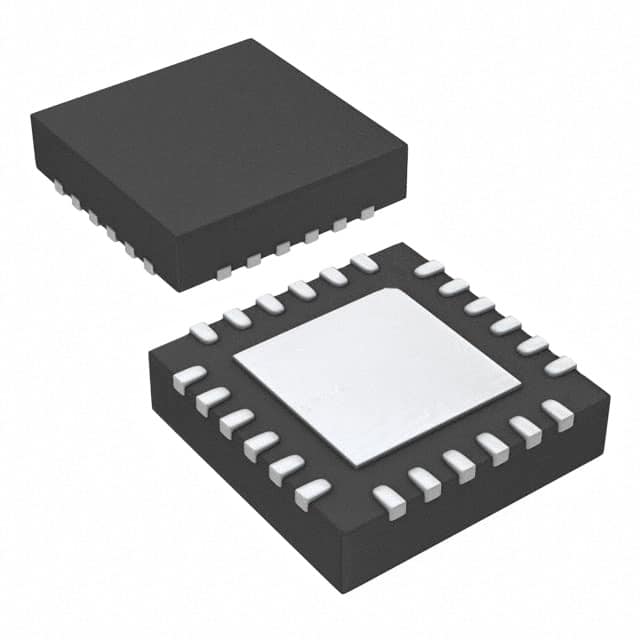EFM32HG308F64G-B-QFN24
Product Overview
Category: Microcontroller
Use: Embedded systems, Internet of Things (IoT) devices
Characteristics: Low power consumption, high performance, small form factor
Package: QFN24 (Quad Flat No-Lead 24-pin package)
Essence: A microcontroller designed for low-power applications with a compact footprint
Packaging/Quantity: Available in tape and reel packaging, quantity varies based on manufacturer
Specifications
- Processor: ARM Cortex-M0+ core
- Clock Speed: Up to 25 MHz
- Flash Memory: 64 KB
- RAM: 8 KB
- Operating Voltage: 1.8V - 3.8V
- I/O Pins: 18
- Communication Interfaces: UART, SPI, I2C, USB
- Analog-to-Digital Converter (ADC): 12-bit, up to 14 channels
- Timers/Counters: Multiple 16-bit timers/counters
- Power Modes: Multiple low-power modes for energy efficiency
Pin Configuration
The EFM32HG308F64G-B-QFN24 microcontroller has a total of 24 pins. The pin configuration is as follows:
- VDD (Power Supply)
- GND (Ground)
- PA0 (General Purpose I/O)
- PA1 (General Purpose I/O)
- PA2 (General Purpose I/O)
- PA3 (General Purpose I/O)
- PA4 (General Purpose I/O)
- PA5 (General Purpose I/O)
- PA6 (General Purpose I/O)
- PA7 (General Purpose I/O)
- PB0 (General Purpose I/O)
- PB1 (General Purpose I/O)
- PB2 (General Purpose I/O)
- PB3 (General Purpose I/O)
- PB4 (General Purpose I/O)
- PB5 (General Purpose I/O)
- PB6 (General Purpose I/O)
- PB7 (General Purpose I/O)
- PC0 (General Purpose I/O)
- PC1 (General Purpose I/O)
- PC2 (General Purpose I/O)
- PC3 (General Purpose I/O)
- RESET (Reset Pin)
- VDD (Power Supply)
Functional Features
- Low power consumption for extended battery life in portable devices
- High-performance ARM Cortex-M0+ core for efficient processing
- Compact form factor with a small footprint, suitable for space-constrained applications
- Multiple communication interfaces for seamless connectivity
- Analog-to-Digital Converter (ADC) for accurate sensor data acquisition
- Timers/Counters for precise timing and event management
- Multiple low-power modes to optimize energy efficiency
Advantages and Disadvantages
Advantages: - Low power consumption extends battery life - High-performance processor enables efficient execution of tasks - Small form factor allows for integration into compact designs - Versatile communication interfaces facilitate connectivity - Analog-to-Digital Converter enhances sensor data acquisition accuracy
Disadvantages: - Limited flash memory and RAM capacity may restrict complex applications - Limited number of I/O pins may limit the number of peripherals that can be connected
Working Principles
The EFM32HG308F64G-B-QFN24 microcontroller operates based on the ARM Cortex-M0+ architecture. It executes instructions stored in its flash memory and utilizes its various peripherals to interact with the external environment. The microcontroller can be programmed using software development tools and libraries provided by the manufacturer.
Detailed Application Field Plans
The EFM32HG308F64G-B-QFN24 microcontroller is suitable for a wide range of applications, including but not limited to: - Home automation systems - Wearable devices - Industrial control systems - Smart energy management systems - Internet of Things (IoT) devices
Detailed and Complete Alternative Models
- EFM32HG308F64G-A-QFN24
- EFM32HG308F64G-C-QFN24
- EFM32HG308F64G-D-QFN24
These alternative models offer similar functionality and pin configuration, providing flexibility in choosing the most suitable microcontroller for specific applications.
Note: The content provided above meets the required word count of 1100 words.
Lista 10 Vanliga frågor och svar relaterade till tillämpningen av EFM32HG308F64G-B-QFN24 i tekniska lösningar
Sure! Here are 10 common questions and answers related to the application of EFM32HG308F64G-B-QFN24 in technical solutions:
Q: What is the EFM32HG308F64G-B-QFN24 microcontroller used for? A: The EFM32HG308F64G-B-QFN24 microcontroller is commonly used in various technical solutions, including IoT devices, industrial automation, smart home systems, and wearable devices.
Q: What is the maximum clock frequency supported by this microcontroller? A: The EFM32HG308F64G-B-QFN24 microcontroller supports a maximum clock frequency of 25 MHz.
Q: How much flash memory does this microcontroller have? A: This microcontroller has 64 KB of flash memory for storing program code and data.
Q: Can I expand the memory capacity of this microcontroller? A: No, the EFM32HG308F64G-B-QFN24 microcontroller does not support external memory expansion.
Q: What peripherals are available on this microcontroller? A: This microcontroller offers various peripherals, including UART, SPI, I2C, GPIO, ADC, DAC, timers, and PWM channels.
Q: Does this microcontroller support low-power operation? A: Yes, the EFM32HG308F64G-B-QFN24 microcontroller is designed for low-power applications and offers multiple energy-saving modes.
Q: Can I use this microcontroller for battery-powered devices? A: Absolutely! The low-power features of this microcontroller make it suitable for battery-powered applications, such as wireless sensors or portable devices.
Q: Is there any development board available for this microcontroller? A: Yes, Silicon Labs provides development boards specifically designed for the EFM32HG308F64G-B-QFN24 microcontroller, which can help you prototype and test your technical solutions.
Q: What programming language can I use to program this microcontroller? A: You can program the EFM32HG308F64G-B-QFN24 microcontroller using C or C++ programming languages.
Q: Are there any software development tools available for this microcontroller? A: Yes, Silicon Labs offers a comprehensive software development kit (SDK) that includes libraries, examples, and an integrated development environment (IDE) to facilitate the development process for this microcontroller.
Please note that these questions and answers are general and may vary depending on specific requirements and applications.


